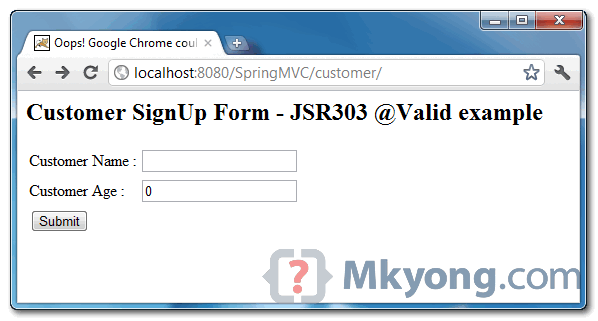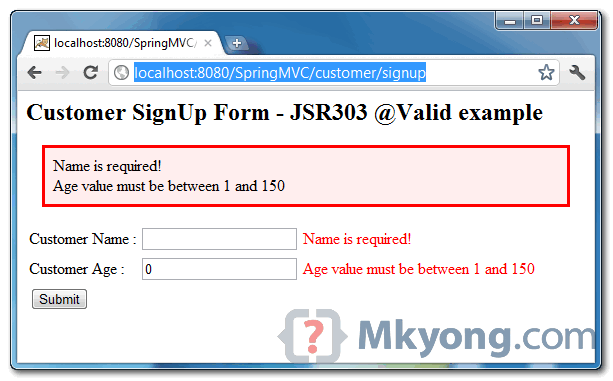Spring 3 MVC and JSR303 @Valid example
http://www.mkyong.com/spring-mvc/spring-3-mvc-and-jsr303-valid-example/
————————————————————————————————————————————————————————
用jsr303验证表单数据,搞了很长时间,验证倒是验证了,但是@Valid不起作用,表现是:
无论是否加@Valid, 都会验证,并且spring无法捕获到异常BindingResult.hasErrors始终是false。
上面那个例子就可以。具体原因还不是很明了,按上面那个例子,对有问题的项目做如下处理:
1 使用<mvc:annotation-driven />
2 去掉DefaultAnnotationHandlerMapping, ControllerClassNameHandlerMapping, AnnotationMethodHandlerAdapter
3 因为去掉了ControllerClassNameHandlerMapping,在控制器做相应处理
————————————————————————————
现在想想之前尝试各种办法都不成功,有没有可能跟这个异常有关系呢?应该没有,之前应该已经尝试过这种情况。
Caused by: java.lang.OutOfMemoryError: PermGen space
————————————————————————————————————————————————————————
In Spring 3, you can enable “mvc:annotation-driven” to support JSR303 bean validation via @Valid annotation,
if any JSR 303 validator framework on the classpath.
Hibernate Validator is the reference implementation for JSR 303
In this tutorial, we show you how to integrate Hibernate validator with
Spring MVC, via @Valid annotation, to perform bean validation in a
HTML form.
Technologies used :
- Spring 3.0.5.RELEASE
- Hibernate Validator 4.2.0.Final
- JDK 1.6
- Eclipse 3.6
- Maven 3
1. Project Dependencies
Hibernate validator is available at JBoss public repository.
<repositories> <repository> <id>JBoss repository</id> <url>http://repository.jboss.org/nexus/content/groups/public/</url> </repository> </repositories> <properties> <spring.version>3.0.5.RELEASE</spring.version> </properties> <dependencies> <!-- Spring 3 dependencies --> <dependency> <groupId>org.springframework</groupId> <artifactId>spring-core</artifactId> <version>${spring.version}</version> </dependency> <dependency> <groupId>org.springframework</groupId> <artifactId>spring-web</artifactId> <version>${spring.version}</version> </dependency> <dependency> <groupId>org.springframework</groupId> <artifactId>spring-webmvc</artifactId> <version>${spring.version}</version> </dependency> <!-- Hibernate Validator --> <dependency> <groupId>org.hibernate</groupId> <artifactId>hibernate-validator</artifactId> <version>4.2.0.Final</version> </dependency> </dependencies>
2. JSR303 Bean Validation
A simple POJO, annotated with Hibernate validator annotation.
package com.mkyong.common.model;
import org.hibernate.validator.constraints.NotEmpty;
import org.hibernate.validator.constraints.Range;
public class Customer {
@NotEmpty //make sure name is not empty
String name;
@Range(min = 1, max = 150) //age need between 1 and 150
int age;
//getter and setter methods
}
3. Controller + @Valid
For validation to work, just annotate the “JSR annotated model object” via
@Valid. That’s all, other stuff is just a normal Spring MVC form
handling.
package com.mkyong.common.controller;
import javax.validation.Valid;
import org.springframework.stereotype.Controller;
import org.springframework.ui.ModelMap;
import org.springframework.validation.BindingResult;
import org.springframework.web.bind.annotation.RequestMapping;
import org.springframework.web.bind.annotation.RequestMethod;
import com.mkyong.common.model.Customer;
@Controller
@RequestMapping("/customer")
public class SignUpController {
@RequestMapping(value = "/signup", method = RequestMethod.POST)
public String addCustomer(@Valid Customer customer, BindingResult result) {
if (result.hasErrors()) {
return "SignUpForm";
} else {
return "Done";
}
}
@RequestMapping(method = RequestMethod.GET)
public String displayCustomerForm(ModelMap model) {
model.addAttribute("customer", new Customer());
return "SignUpForm";
}
}
4. Error Message
By default, if validation failed.
@NotEmptywill display “may not be empty”@Rangewill display “must be between 1 and 150″
You can override it easily, create a properties with “key” and message. To
know which @annotation bind to which key, just debug it and view value inside
“BindingResult result“. Normally, the key is “@Annotation
Name.object.fieldname“.
File : messages.properties
NotEmpty.customer.name = Name is required!
Range.customer.age = Age value must be between 1 and 1505. mvc:annotation-driven
Enable “mvc:annotation-driven” to make Spring MVC supports
JSR303 validator via @Valid, and also bind your properties
file.
<beans xmlns="http://www.springframework.org/schema/beans" xmlns:context="http://www.springframework.org/schema/context" xmlns:mvc="http://www.springframework.org/schema/mvc" xmlns:xsi="http://www.w3.org/2001/XMLSchema-instance" xsi:schemaLocation=" http://www.springframework.org/schema/beans http://www.springframework.org/schema/beans/spring-beans-3.0.xsd http://www.springframework.org/schema/context http://www.springframework.org/schema/context/spring-context-3.0.xsd http://www.springframework.org/schema/mvc http://www.springframework.org/schema/mvc/spring-mvc-3.0.xsd"> <context:component-scan base-package="com.mkyong.common.controller" /> <!-- support JSR303 annotation if JSR 303 validation present on classpath --> <mvc:annotation-driven /> <bean id="viewResolver" class="org.springframework.web.servlet.view.InternalResourceViewResolver"> <property name="prefix"> <value>/WEB-INF/pages/</value> </property> <property name="suffix"> <value>.jsp</value> </property> </bean> <!-- bind your messages.properties --> <bean class="org.springframework.context.support.ResourceBundleMessageSource" id="messageSource"> <property name="basename" value="messages" /> </bean> </beans>
6. JSP Pages
Last one, normal JSP page with Spring form tag library.
File : SignUpForm.jsp
<%@ taglib prefix="form" uri="http://www.springframework.org/tags/form"%> <html> <head> <style> .error { color: #ff0000; } .errorblock { color: #000; background-color: #ffEEEE; border: 3px solid #ff0000; padding: 8px; margin: 16px; } </style> </head> <body> <h2>Customer SignUp Form - JSR303 @Valid example</h2> <form:form method="POST" commandName="customer" action="customer/signup"> <form:errors path="*" cssClass="errorblock" element="div" /> <table> <tr> <td>Customer Name :</td> <td><form:input path="name" /></td> <td><form:errors path="name" cssClass="error" /></td> </tr> <tr> <td>Customer Age :</td> <td><form:input path="age" /></td> <td><form:errors path="age" cssClass="error" /></td> </tr> <tr> <td colspan="3"><input type="submit" /></td> </tr> </table> </form:form> </body> </html>
File : Done.jsp
<html> <body> <h2>Done</h2> </body> </html>
6. Demo
URL : http://localhost:8080/SpringMVC/customer – Customer form page, with 2 text boxes for name and age.

URL : http://localhost:8080/SpringMVC/customer/signup – If you didn’t fill in the form and click on the “submit” button, your customized validation error messages will be displayed.

Download Source Code
References
郑重声明:本站内容如果来自互联网及其他传播媒体,其版权均属原媒体及文章作者所有。转载目的在于传递更多信息及用于网络分享,并不代表本站赞同其观点和对其真实性负责,也不构成任何其他建议。





































